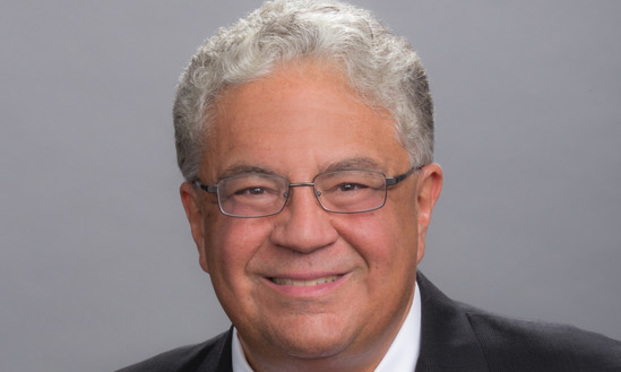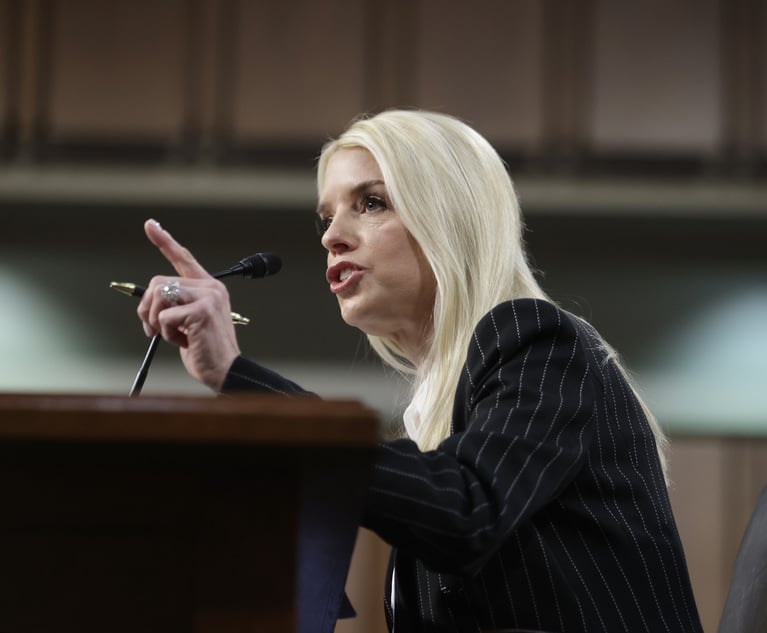Loan Forgiveness Rules Under the PPP and Its Impact on Medical, Dental Clients
Now that many small businesses have actually received their PPP loan funds, thereby triggering the eight-week coverage period, the fundamental question has become: How much of my loan will be forgiven, and what will I need to do to apply for forgiveness?
April 27, 2020 at 01:22 PM
6 minute read
 Vasilios "Bill" Kalogredis.
Vasilios "Bill" Kalogredis.The application process for the Small Business Administration's (SBA) Paycheck Protection Program (PPP) began on April 3. Since then, over a million businesses, including many physicians, dentists and small practice groups trying to keep their practices afloat, have scrambled to complete the borrower application form and gather the supporting documentation to submit to their lenders. Borrowers are now beginning to be notified that their application has been approved, and some have already received their loan proceeds. Those who did not act fast enough have unfortunately missed the boat—as of April 16, the SBA announced it officially ran out of money, hitting its $350 billion cap under the Coronavirus Aid, Relief, and Economic Security (CARES) Act. It is possible that this cap will be increased by Congress by the time this article is published.
Now that many small businesses have actually received their PPP loan funds, thereby triggering the eight-week coverage period, the fundamental question has become: How much of my loan will be forgiven, and what will I need to do to apply for forgiveness?
The CARES Act places restrictions on how borrowers can use loan proceeds from the PPP and also provides for forgiveness of up to the full principal amount of a PPP loan and any interest accrued thereon, for documented, qualifying expenditures made during the specified covered period. It sets forth the qualifying expenditures, the covered period during which such expenditures must be made, the calculation to be used for determining a borrower's forgiveness amount and certain actions and expenditures that can reduce the forgiveness amount.
The Eight-Week Coverage Period
The amount of the PPP loan eligible for forgiveness will depend on how the borrower uses the loan proceeds during the eight-week period immediately following the borrower's receipt of the loan. The eight-week period begins on the date the lender makes the first disbursement of the PPP loan to the borrower. Thus, borrowers should be planning ahead to maximize their loan forgiveness. The lender must make the first loan disbursement no later than 10 calendar days from the date of loan approval.
Qualifying Expenditures
The maximum amount of a PPP loan that is eligible for forgiveness is equal to the amount an employer has both incurred and spent on qualifying expenses during the eight-week coverage period, beginning on the loan origination date. Qualifying expenses include the following:
- Payroll costs, including salaries, wages and commissions (not to exceed $100,000 per employee) and certain other noncash benefits (e.g,. group health care benefits (including insurance premiums), retirement benefits, and state and local taxes assessed on employee compensation);
- Paid sick, medical or family leave where no tax credits were taken;
- Mortgage interest payments (but not mortgage prepayments or principal payments);
- Rent payments;
- Utilities payments; and
- Interest payments on any other debt obligations that were incurred before Feb. 15.
Examples of ineligible expenses include: accounts payable, including payments made to proprietorships and independent contractors; life insurance costs; principal portions of mortgage or other debt payments; and payments of interest on other debt obligations established after Feb. 15.
For physician and dentist clients, it is important to note that doctors may use PPP funds to purchase medical supplies and equipment, but these expenditures will not qualify for forgiveness under the current PPP rules.
Conditions for Forgiveness
Based on guidance from the CARES Act and the SBA interim final rule, there are currently three factors that may impact loan forgiveness:
- The 75/25 Rule—At least 75% of the loan must be used for payroll costs.
- Reduction in salary/wages—A major objective of the PPP loan program was to keep employees working. As a result, the CARES Act provides that the amount of loan forgiveness will be reduced by the amount of any reduction in total salary or wages of any employee that exceeds 25% of such employee's total salary or wages during the most recent full quarter during which the employee was employed before the eight-week covered period. This reduction rule applies to employees who did not receive, during any single pay period during 2019, wages or salary at an annualized rate of pay in an amount more than $100,000.
- Reduction in FTEs—The amount of the forgivable portion of the loan will be reduced for a decrease in the number of FTEs over the covered period. FTEs for the purposes of this calculation do not include employees who earn more than $100,000 annually.
Required Documentation
The required documents that a borrower will need to collect and provide with its PPP forgiveness application at the end of the eight-week period will vary by lender. However, it is likely that most lenders will require, at minimum, the following information to apply for forgives:
- A detailed explanation of how the loan proceeds were used;
- Payroll reports and payroll tax filings;
- Bank statements from the account where the funds were deposited through the time of application for forgiveness;
- Copies of all statements of interest paid on debt obligations incurred prior to Feb. 15, indicating payment amounts and proof of payment for the eight-week coverage period;
- Copies of cancelled checks, statements or other evidence of rent and utilities paid during the "covered period" for the eight-week coverage period; and
- A certification from an authorized representative of the borrower stating that the amount for which forgiveness is requested was used for appropriate purposes.
Lenders then will have 60 days to make a determination on the amount of loan forgiveness and notify the borrower.
The rules and requirements for applying for loan forgiveness under the Paycheck Protection Program are changing daily. So borrowers should be sure to consult with their advisors to make the proper steps. One thing that is certain is that it will require detailed planning, precise execution, and meticulous documentation for small businesses, including our healthcare clients, to qualify.
—Rachel E. Lusk, an associate at Lamb McErlane who focuses on health law and health care litigation, assisted with preparing this article.
Vasilios J. Kalogredis is chairman of Lamb McErlane's health law department. He represents many medical and dental groups and thousands of individual physicians and dentists.
This content has been archived. It is available through our partners, LexisNexis® and Bloomberg Law.
To view this content, please continue to their sites.
Not a Lexis Subscriber?
Subscribe Now
Not a Bloomberg Law Subscriber?
Subscribe Now
NOT FOR REPRINT
© 2025 ALM Global, LLC, All Rights Reserved. Request academic re-use from www.copyright.com. All other uses, submit a request to [email protected]. For more information visit Asset & Logo Licensing.
You Might Like
View All
Lawyers' Phones Are Ringing: What Should Employers Do If ICE Raids Their Business?
6 minute read


3rd Circuit Strikes Down NLRB’s Monetary Remedies for Fired Starbucks Workers
Law Firms Mentioned
Trending Stories
- 1Uber Files RICO Suit Against Plaintiff-Side Firms Alleging Fraudulent Injury Claims
- 2The Law Firm Disrupted: Scrutinizing the Elephant More Than the Mouse
- 3Inherent Diminished Value Damages Unavailable to 3rd-Party Claimants, Court Says
- 4Pa. Defense Firm Sued by Client Over Ex-Eagles Player's $43.5M Med Mal Win
- 5Losses Mount at Morris Manning, but Departing Ex-Chair Stays Bullish About His Old Firm's Future
Who Got The Work
J. Brugh Lower of Gibbons has entered an appearance for industrial equipment supplier Devco Corporation in a pending trademark infringement lawsuit. The suit, accusing the defendant of selling knock-off Graco products, was filed Dec. 18 in New Jersey District Court by Rivkin Radler on behalf of Graco Inc. and Graco Minnesota. The case, assigned to U.S. District Judge Zahid N. Quraishi, is 3:24-cv-11294, Graco Inc. et al v. Devco Corporation.
Who Got The Work
Rebecca Maller-Stein and Kent A. Yalowitz of Arnold & Porter Kaye Scholer have entered their appearances for Hanaco Venture Capital and its executives, Lior Prosor and David Frankel, in a pending securities lawsuit. The action, filed on Dec. 24 in New York Southern District Court by Zell, Aron & Co. on behalf of Goldeneye Advisors, accuses the defendants of negligently and fraudulently managing the plaintiff's $1 million investment. The case, assigned to U.S. District Judge Vernon S. Broderick, is 1:24-cv-09918, Goldeneye Advisors, LLC v. Hanaco Venture Capital, Ltd. et al.
Who Got The Work
Attorneys from A&O Shearman has stepped in as defense counsel for Toronto-Dominion Bank and other defendants in a pending securities class action. The suit, filed Dec. 11 in New York Southern District Court by Bleichmar Fonti & Auld, accuses the defendants of concealing the bank's 'pervasive' deficiencies in regards to its compliance with the Bank Secrecy Act and the quality of its anti-money laundering controls. The case, assigned to U.S. District Judge Arun Subramanian, is 1:24-cv-09445, Gonzalez v. The Toronto-Dominion Bank et al.
Who Got The Work
Crown Castle International, a Pennsylvania company providing shared communications infrastructure, has turned to Luke D. Wolf of Gordon Rees Scully Mansukhani to fend off a pending breach-of-contract lawsuit. The court action, filed Nov. 25 in Michigan Eastern District Court by Hooper Hathaway PC on behalf of The Town Residences LLC, accuses Crown Castle of failing to transfer approximately $30,000 in utility payments from T-Mobile in breach of a roof-top lease and assignment agreement. The case, assigned to U.S. District Judge Susan K. Declercq, is 2:24-cv-13131, The Town Residences LLC v. T-Mobile US, Inc. et al.
Who Got The Work
Wilfred P. Coronato and Daniel M. Schwartz of McCarter & English have stepped in as defense counsel to Electrolux Home Products Inc. in a pending product liability lawsuit. The court action, filed Nov. 26 in New York Eastern District Court by Poulos Lopiccolo PC and Nagel Rice LLP on behalf of David Stern, alleges that the defendant's refrigerators’ drawers and shelving repeatedly break and fall apart within months after purchase. The case, assigned to U.S. District Judge Joan M. Azrack, is 2:24-cv-08204, Stern v. Electrolux Home Products, Inc.
Featured Firms
Law Offices of Gary Martin Hays & Associates, P.C.
(470) 294-1674
Law Offices of Mark E. Salomone
(857) 444-6468
Smith & Hassler
(713) 739-1250





